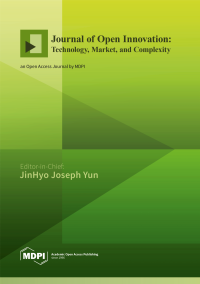New Directions of Open Innovation, and Business Model with Digital Transformation
A special issue of Journal of Open Innovation: Technology, Market, and Complexity (ISSN 2199-8531).
Deadline for manuscript submissions: closed (31 December 2022) | Viewed by 82833
Special Issue Editors
Interests: open innovation; business model; open innovation economy; social open innovation; Schumpeterian dynamics; complexity; game theory; political economics
* Managing Guest Editor
Interests: critical success factors of small and medium sized enterprises; innovation; financial aspects of business
Interests: management and policy of healthcare technology; innovation system for healthcare technology; strategic entrepreneurship in healthcare industry; digital healthcare
Special Issue Information
Dear Colleagues,
This Special Issue will publish some selected papers from the annual conference of SOI 2022. Suitable topics include, but are not limited to:
- Micro- and macroeconomics of open innovation dynamics;
- Open business models;
- Schumpeterian economics, growth of knowledge, and open innovation;
- Sharing economy and open business model platforms;
- Digital transformation;
- Inter-rationality in open innovation dynamics;
- Matching between technology and market under open innovation dynamics;
- Finance open innovation.
Time schedule of this Special Issue:
- Special Issue Open: 1 March 2022
From 1 March 2022, any SOI 2022 authors in addition to the planned papers can submit to this Special Issue after full paper submission to SOI 2022 platform and paying the registration fee until 10th June 2022.
- Close: 31 December 2022
All papers should be submitted to this Special Issue until 31 December 2022.
- SOI 2022 best paper recommendation condition
The best paper award of SOI 2022 will be chosen from papers which were selected for the Special Issue of JOI for SOI 2022, and submitted at the JOI until 1st July 2022.
- SOI 2022 keynote papers
The Article Processing Charges (APC) of the keynote speech papers of SOI 2022 will be supported by SOI if the paper was passed the regular review process. The authors of these papers should include an acknowledgement section following the example below:
Funding: This paper was presented as a keynote speech of SOI 2022, and the publishing fee was supported by SOI.
Prof. Dr. JinHyo Joseph Yun
Prof. Dr. Natalja Lace
Dr. Kwangsoo Shin
Dr. Giovanna Del Gaudio
Guest Editors
Manuscript Submission Information
Manuscripts should be submitted online at www.mdpi.com by registering and logging in to this website. Once you are registered, click here to go to the submission form. Manuscripts can be submitted until the deadline. All submissions that pass pre-check are peer-reviewed. Accepted papers will be published continuously in the journal (as soon as accepted) and will be listed together on the special issue website. Research articles, review articles as well as short communications are invited. For planned papers, a title and short abstract (about 100 words) can be sent to the Editorial Office for announcement on this website.
Submitted manuscripts should not have been published previously, nor be under consideration for publication elsewhere (except conference proceedings papers). All manuscripts are thoroughly refereed through a single-blind peer-review process. A guide for authors and other relevant information for submission of manuscripts is available on the Instructions for Authors page. Journal of Open Innovation: Technology, Market, and Complexity is an international peer-reviewed open access quarterly journal published by MDPI.
Please visit the Instructions for Authors page before submitting a manuscript. The Article Processing Charge (APC) for publication in this open access journal is 800 CHF (Swiss Francs). Submitted papers should be well formatted and use good English. Authors may use MDPI's English editing service prior to publication or during author revisions.







